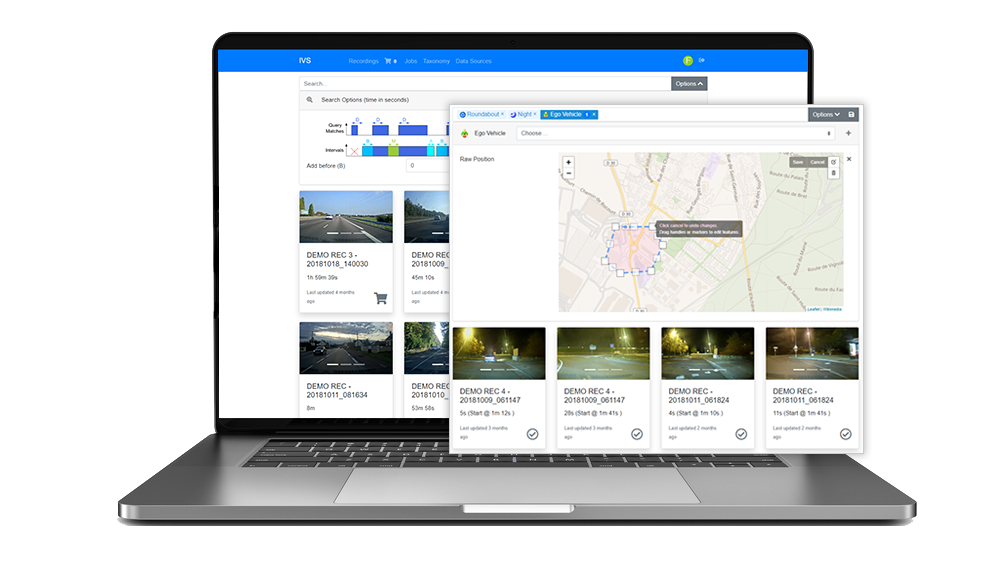Intempora Validation Suite™
Manage. Search. Find relevant data. Test. Automate. Validate your algorithms.
Manage all your sensor data then test and validate perception and deep learning algorithms against PetaBytes of recorded and
relevant situations.

What is IVS?
IVS - Intempora Validation Suite™
Sensor data management platform for Autonomous vehicles
IVS (Intempora Validation Suite) is a cloud-based validation software toolchain for training, testing, benchmarking and validating ADAS (Advanced Driver Assistance Systems) and HAD (Highly Automated Driving) software functions including perception and deep learning algorithms against large driving sensor datasets stored in big data architectures in the cloud or on-premise.
Intempora mutualized customer requests since several years to design and deliver a cloud-based data manager, a test automation framework and unique methods and workflow to enable the deployment of autonomous vehicles on the road much faster than ever before.

Why IVS - Intempora validation suite ?
Efficiently manage PetaBytes of data and automate the testing & validation of your ADAS and AD software functions
As automated vehicles systems become extremely data intensive with millions of km of test drives and tens of PetaBytes of recorded sensors dataset, automotive engineers require a complete and intuitive software toolchain to test and validate ADAS (advanced driving assistance systems) and HAD (highly automated driving) software functions against relevant data and scenarios.

The test and development processes to manage, search, use, test and validate algorithms with relevant datasets is becoming extremely time consuming especially when you need to chose the relevant data necessary to know how a self-dring car might drive in a variety of road conditions. Developers, IT and data engineers need to collaborate efficiently and rethink their infrastructure for unstructured data that require extreme durability with fast and easy retrieval. With IVS from Intempora we aim to answer these challenges and delivers a seamless end-to-end workflow in order to accelerate the training and validation of autonomous systems algorithms and put smart vehicles on the road faster.

IVS™
The most innovative sensor data management platform to accelerate and simplify the testing and validation of ADAS and automated driving software functions.
IVS KEY features
Friendly user interface
Ingest and manage your data through an intuitive web-based application and a friendly user-interface.
Seamless workflow
Develop and test in a unified and seamless validation workflow with versatile software tools and reduce time wasted on repetitive tasks.
Worldwide sharing
Mutualize efforts and share recorded test driving and simulated datasets all over the world with your teams, partners and providers thanks to a centralized data manager hosted on your favorite cloud-based architecture.
Scalability
Take advantage of the flexibility and scalability of cloud-based architecture for accelerating parallel tasks combining high-performance software execution and hardware processing never achieved before.
Search and Filter
Thanks to a complete taxonomy of keywords and accurate queries, you can find, select and extract sub sequences of recordings in order to train and and validate autonomous driving algorithm. Find edge cases in petabytes of data in matter of seconds!
Open
IVS is an open and modular software toolchain, customize IVS web interface at your convenience and interface your proven-in use technologies such as your simulator for extracting ground truth, your labelling tool for data enrichment, data analytics or KPIs monitoring software.
Get the most
Take the most out of your big data infrastructure and drastically reduce time efforts offline searching, testing duration and cost. IVS is enables to short the test and validation process of your system and put vehicles on the road faster.
ivs BENEFITS
As validation and verification are becoming more and more complex due to billions of kiliometers cumulated for testing and huge amounts of recorded data, it becomes essential for engineering teams to use advanced solutions to solve the next big data challenge of the automotive industry.
IVS – Intempora validation suite delivers a complete a unique software toolchain which allow to dramatically reduce lifecycle validation by post-processing algorithms in the cloud against terabytes of recorded driving and simulated data and improve development process by time saving hours of searching, finding and extracting relevant data scenarios to post-process algorithms in order to train and validate them .
For developers
- STORE and MANAGE data efficiently thanks to state-of-the art big data technologies.
- BENEFIT of a seamless workflow between Intempora software tools.
- ANNOTATE data automatically with RTMaps-based algorithms.
- PLUG IN your own labelling tools.
- SEARCH for situations with your customized taxonomy and accurate queries.
- PREVIEW and VISUALIZE data online.
- FIND and EXTRACT only relevant sub sequences from your recorded datasets.
- POST-PROCESS with own middlewares with playback or simulated data.
- TAKE advantage of high scalibility and performance with cloud-based architectures.
For your company
- EXCHANGE and SHARE data across your teams all over the world thanks to a centralized data manager hosted on cloud architectures.
- MANAGE permissions for users, partners, data or algorithm providers and KEEP CONTROL on your recorded data.
- MONITOR situational statistics in your data lake and feed your fleet of data-collection vehicles.
- GET the most out of your cloud infrastructure with optimized post-processing software such as RTMaps.
- OPTIMIZE offline testing duration.
- REDUCE workload and SAVE time and costs.
- BENEFIT of ready to use algorithms off-the-shelf for automated annotation.
- ACCELERATE time to market and bring your vehicles on the road.
IVS GALLERY






Unleash the power of data
MANAGe, SEARCH and find relevant DATA in A matter of seconds!
What can i do with MY DATA and IVS?
An end-to-end software toolchain to drive validation
With the constant increase of sensors integrated on vehicles and robots and the permanent evolution of hardware and software technologies, it becomes necessary for engineers and developers to find efficient and versatile tools that can manage the rapid evolution of these technologies, especially in the autonomous driving industry.
IVS allows automotive engineers to centralize, store, and share their recorded driving situations with raw sensor data on the cloud or on-premises, index them, annotate, then search for particular situations, preview and visualize results, prepare and automate the post-processing of such amount of driving data on parallel high-performance computing clusters, then validate perception and deep learning algorithms.
IVS is made of two main software modules.
Data Manager
The Intempora Data Manager is the visible part of the IVS software toolchain. It’s a centralized big database with a web-portal interface able to store, re-index, preview and search particular driving scenarios among large amounts of recorded data (up to PetaBytes, including video streams, Lidars, Radars, GPS, CAN, Biometrics and any other automotive sensor data).
Test and Automation Manager
The Intempora Test and Automation Manager allows engineers to inject their own ADAS and automated driving software functions such as perception and deep learning algorithms in the cloud and automate post-processing tasks in a distributed manner on clusters of computing nodes in your cloud environment.
WORKFLOW AND ARCHITECTURE OF IVS



Complementary software tools
RTMaps
Thanks to RTMaps (Real-Time Multisensor applications), automotive engineers can develop high-end in car data recording systems, design perception and deep learning algorithms, software features for integration, execution and testing. RTMaps can be used in IVS as a post-processing framework in the cloud.
- Open File formats
- No software performance limitation, hardware.
- Record data sensors track by track with no entralaced data
- As fast as possible recording method without data losses
RTag
RTag is a live anual tagging software application available on tactile tablet. Connected to your data logging system, it becomes easy to manually monitor sensors recording on your vehicle, then manually annotate with tags while driving in conjuction with potentional annotation algorithms running in real-time in your data recorder.
- Intuitive web-based application
- Control and monitor your sensors recording configuration
- Annotate manually easily among numerous tags
- Define clock for automatic synchronization
Put autonomous vehicle on the road faster
Automatically validate adas AND AUTOMATED DRIVING SOFTWARE FUNCTIONS
10 essential steps to validate your AD algorithms against petabytes
1
Ingest and Store Data
Developing advanced software functions and algorithms depends on data gather during real test drives conditions. Autonomous vehicles are collecting more than 10TB of raw sensor data daily. Thanks to IVS and hardware provided by partners you can record, store then ingest all your data easily.
2
Centralize and share Data
To exploit and manage efficiently these large raw volume of sensor data, your infrastructure need to be centralize. It allows you to earn flexibility and efficiency especially when it comes to share these large dataset with different teammates located all around the world.
3
Annotate Data
Data annotation is a neccessary step in the validation process in order to generate high-quality datasets. Annotation can be done manually thanks to labeling software tools such as RTag or automatically in the cloud with the Data Annotation Pack, a set of algorithms to automatically annotate your datasets.
4
Enrich Data
Data enrichment is necessary to enhance ground truth and to train and validate your AI efficiently. Autonomous vehicles need good data. In combination with standard annotation methods, you can enrich your dataset with post-processing methods and set of algorithms to extract tags and metadata from HD Maps (number of lanes, road signs) or weather.
5
Search and Filter Data
After annotation, it becomes easy to search particular situations with a centralized database thanks to indexed tags. You can select the corresponding situations with different queries in order to filter and find relevant data, scenarios and subsequences of data to define a good quality dataset of edge cases to train or validate your algorithms.
6
Preview and Visualize Data
Preview and visualize the data can be necessary to check if the corresponding sub sequences is relevant according to your research and can be useful to detect fault detections / annotation errors quicly. Moreover you can have a complete overview about the full recording with informations (timeline, date, map, sensors configuration, vehicle platform and so on..)
7
Select and Prepare algorithm
When all relevant data are found thanks to different queries you can select these data and prepare your dataset, then you can pick algorithm by uploading your model on the system in order to execute jobs and post-process your AI on the corresponding dataset you selected previously.
8
Post-process algorithm
When all your algorithms are ready and relevant data selected you can execute jobs and post process your algorithm in big data architectures, you can execute jobs in parallel and take advantage of big data architecture and optimized post-processing framework to save time and costs.
9
Train your algorithms
Training algorithms are hard, especially when it comes to optimize, train and validate deep learning and neural networks. With a centralized database, an intuitive data manger and optimized framework you can enhance rapidly the accuracy of your algorithm in different uses cases and scenarios and extract KPIs and observe results.
10
Validate your algorithms
Data are the “fuel” of autonomous driving. To train, then validate perception and deep learning (neural networks) algorithms, engineers need three essentials:
- Large datasets: The amount of raw data volume needed to train AI for self-driving cars is considerable.
- Varied datasets: To train and enhance algorithms you need differents environments, uses cases and situations.
- Real dataset: Simulated data can help and be useful to reproduce complex and dangerous situations rapidly but definitely not sufficient to cover the unpredactability and the weirdness of the real word.
Get started with IVS™ now!